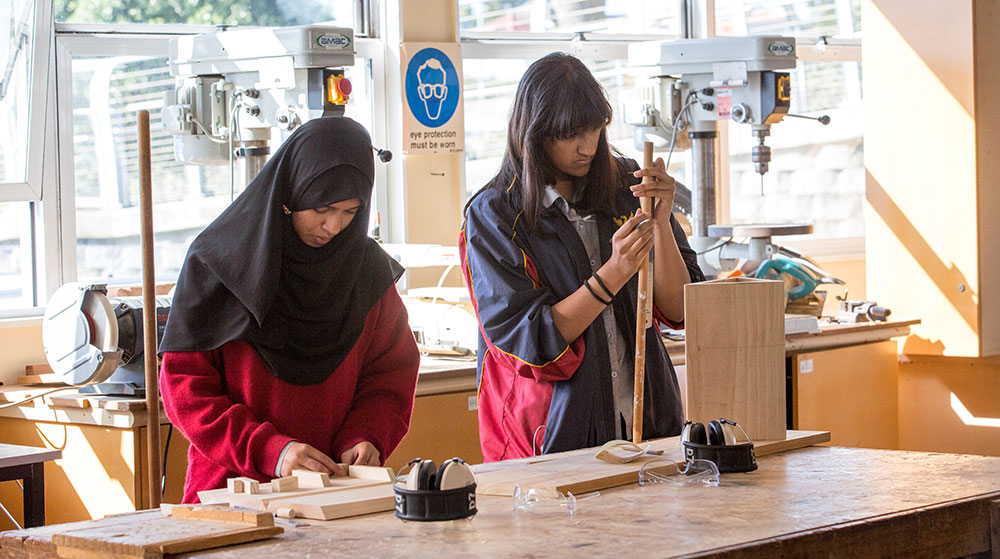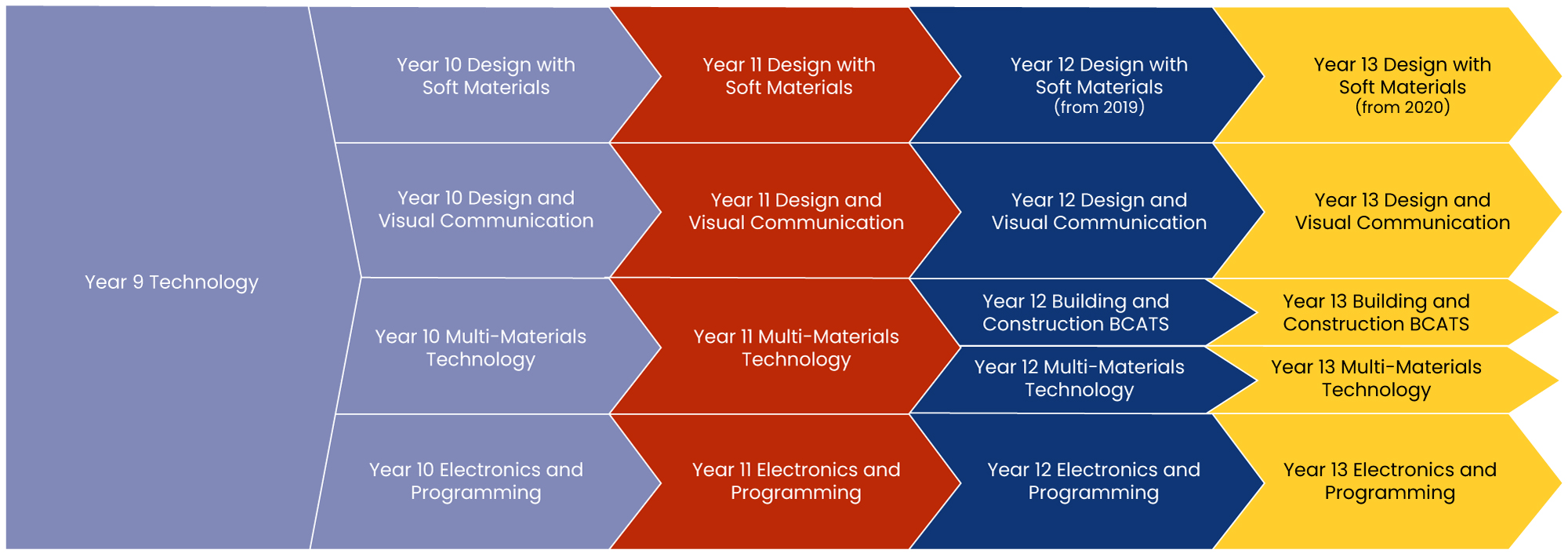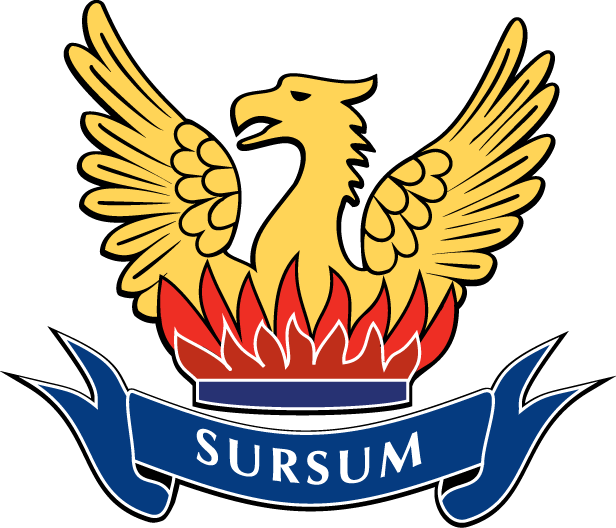In Technology we aim to empower our learners to become creative and confident technologists, critical thinkers who can tackle real world problems and develop innovative design solutions.

We strive to develop students’ understanding of the nature of technology, the way that it has and will continue to change the world around us and the potential they have to influence and contribute to these changes. We focus on learning that occurs within authentic, meaningful contexts that are relevant to students and provide opportunities for peer collaboration that models real world practice. Our students develop the skills required to work effectively in design or project teams and understand the value of being able to draw on individuals’ strengths and expertise.
In Technology students learn by undertaking technological practice that sees them shift from computer programming or CAD to workshop, drawing board to design critique. Our year 9 course is project based with students working in teams across different specialist areas. From year 10 onward students specialise in chosen areas of technology with many students opting to take more than one technology subject and often merging projects together across disciplines.
Courses and Pathways

Year 9 Technology
Year 10 Electronics and Programming
Year 10 Multi-Materials Technology
Year 10 Design with Soft Materials
Year 10 Design and Visual Communication
Year 11 Design and Visual Communication
Year 11 Design with Soft Materials
Year 11 Multi-Materials Technology
Year 11 Electronics and Programming
Year 12 Design and Visual Communication
Year 12 Design with Soft Materials
Year 12 Multi-Materials Technology
Year 12 Electronics and Programming
Year 12 Building and Construction BCATS
Year 13 Design and Visual Communication
Year 13 Design with Soft Materials
Year 13 Multi-Materials Technology
Year 13 Electronics and Programming
Year 13 Building, Construction and Allied Trade Skills
Year 9 Technology
Year 9 Technology
Entry Requirements:
N/A
Junior Diploma Credits:
9
BYOD Recommendations:
N/A
Who is this course for?
N/A
Year 10 Electronics and Programming
Year 10 Electronics and Programming
Entry Requirements:
N/A
Credits:
N/A
BYOD Recommendations:
N/A
Who is this course for?
Those who want to learn and utilise electronic systems to create innovative solutions
Year 10 Multi-Materials Technology
Year 10 Multi-Materials Technology
Entry Requirements:
N/A
Credits:
N/A
BYOD Recommendations:
N/A
Who is this course for?
This course is for students who enjoy designing and making in a workshop environment and developing skills for trade related Industry or year 11 TMM.
Year 10 Design with Soft Materials
Year 10 Design with Soft Materials
Entry Requirements:
N/A
Credits:
N/A
BYOD Recommendations:
N/A
Who is this course for?
This course is for students who are interested in pursuing a career in any design related industry. Students will develop a wide range of fundamental transferable design skills including sketching, modelling, CAD and garment construction.
Year 10 Design and Visual Communication
Year 10 Design and Visual Communication
Entry Requirements:
N/A
Credits:
N/A
BYOD Recommendations:
N/A
Who is this course for?
This course is for students who are interested in developing a wide range of fundamental transferable design skills and are considering taking DVC in Year 11. Students are given challenging Product and Spatial design issues and learn how to explore a range of ideas before developing a well refined solution. Our students learn how to communicate and explore their ideas with detailed design sketches, models and different CAD programmes.
Year 11 Design and Visual Communication
Year 11 Design and Visual Communication
Entry Requirements:
N/A
Credits:
Up to 18 Credits at Level 1
BYOD Recommendations:
Min. 2.5Ghz, 64bit processor, min. 2G dedicated Graphics card
Who is this course for?
This course is for students who are interested in developing a strong foundation of design process and visual communication knowledge and skills and are interested in taking DVC in year 12. Students will apply clever design thinking and a range of visual communication methods to exploring and refining design ideas. Our students engage with modelling, CAD, freehand and technical communication techniques that enable them to develop and present their design work with flair.
Achievement Standards:
AS 91063 1.30 Produce freehand sketches that communicate design ideas. EXT
AS 91064 1.31 Produce instrumental, multiview orthographic drawings that communicate technical features of design ideas. EXT
AS 91065 1.32 Produce instrumental paraline drawings to communicate design ideas. EXT
AS 91067 1.34 Use the work of an influential designer to inform design ideas INT
AS 91068 1.35 Undertake development of design ideas through graphics practice. INT
AS 91066 1.33 Use rendering techniques to communicate the form of ideas. (this is offered as an extension to those students who have complete the above standards within the allocated time) INT
Year 11 Design with Soft Materials
Year 11 Design with Soft Materials
Entry Requirements:
N/A
Credits:
Up to 19 Credits at Level 1
BYOD Recommendations:
64-bit Operating System, 2.5GHz CPU, 2D Graphics card (Dedicated GPU), Min 8Gb RAM
Who is this course for?
This course is for students who are interested in developing a wide range of fundamental and transferable design skills and are considering taking DSM in Year 12. Students will explore new construction techniques and learn how to manipulate patterns that allow them to create their own design ideas for product and garment design. (Please note that although there is no year 12DSM course available in 2018 we intend to offer a year 12 course in 2019 dependant on student numbers).
Achievement Standards:
AS 91068 1.35 Undertake development of design ideas through graphics practice. 6 INT
AS 91063 1.30 Produce freehand sketches to communicate own design ideas. 3 EXT
AS 91096 1.26 Make basic adaptations to a pattern to enable a design to fit a person or item. 4 INT
AS 91058 1.21 Implement basic procedures using textile material to make a specified product. 6 INT
Year 11 Multi-Materials Technology
Year 11 Multi-Materials Technology
Entry Requirements:
N/A
Credits:
16 Credits at Level 1
BYOD Recommendations:
Min. 2.5Ghz, 64bit processor, min. 2G dedicated Graphics card
Who is this course for?
This course is for students who enjoy practical, hands on learning in the timber and metal workshops and are interested in designing and making their own technological products. This course can be assessed using Achievement Standards and/or Unit Standards and offers endorsement in Technology or pathways into the Construction and Engineering Courses offered at this school (these options can be discussed with the student/guardians at the start of the year). This course leads to careers such as, Engineering, Construction, Cabinet making, Manufacture and Architecture and is recognised as a UE entrance subject at level 3 NCEA.
Achievement Standards:
AS 91046 Use design ideas to produce a conceptual design for an outcome to address a brief INT
AS 91047 1.4 Undertake development to make a prototype to address a brief INT
AS 91057 1.2 Implement basic procedures using resistant materials to make a specified product INT
AS 91049 1.6 Demonstrate understanding of how materials enable technological products to function EXT
Level 2 US 2395 Select, use and care for engineering hand tools INT
Level 1 US 4433 Select, use and care for simple measuring devices in engineering INT
Level 2 US 12927 Identify, select, maintain, and use hand tools for BCATS projects INT
Level 1 US 24352 Demonstrate knowledge and apply safe working practices in BCATS project INT
Year 11 Electronics and Programming
Year 11 Electronics and Programming
Entry Requirements:
N/A
Credits:
16 Credits at Level 1
BYOD Recommendations:
Min. 2.5Ghz, 64bit processor, min. 2G dedicated Graphics card
Who is this course for?
This course is for students who want to develop electronics and programming theory, knowledge and skills. Students will develop understanding of and apply key concepts of the ICT and electronics industries that have transformed our society. This course will give students foundational knowledge that supports pathways to Engineering or Technology careers.
Achievement Standards:
AS 91076 1.46 Create a computer program INT
AS 91077 1.47 Demonstrate understanding of basic concepts used in the design and construction of electronic environments INT
AS 91078 1.48 Implement basic interfacing procedures in a specified electronic environment INT
AS 91079 1.49 Implement basic techniques in constructing a specified electronic and embedded system INT
AS 91057 1.20 Implement basic procedures, using resistant materials to make a specified product INT
AS 91050 1.7 Demonstrate understanding of the role of subsystems in technological systems EXT
Year 12 Design and Visual Communication
Year 12 Design and Visual Communication
Entry Requirements:
At least 12 credits from 11DVC Level 1
Credits:
Up to 18 Credits at Level 2
BYOD Recommendations:
Min. 2.5Ghz, 64bit processor, min. 2G dedicated Graphics card
Who is this course for?
This course is for students who want to further develop a range of design skills linked to product and spatial design contexts and who are considering taking DVC in Year 13. Students learn about the place of design in society and generate and explore design ideas in response to challenging and authentic needs or issues. Our students engage with modelling, CAD, freehand and technical communication techniques that enable them to develop and present their design ideas with flair.
Achievement Standards:
AS 91337 2.30 Use visual communication techniques to generate design ideas EXT
AS 91340 2.33 Use the characteristics of a design movement or era to inform own design ideas INT
AS 91341 2.34 Develop a spatial design through graphics practice INT
AS 91342 2.35 Develop a product design through graphics practice INT
Year 12 Design with Soft Materials
Year 12 Design with Soft Materials
Offered in 2019
Year 12 Multi-Materials Technology
Year 12 Multi-Materials Technology
Entry Requirements:
s Achieved AS 91046 and AS 91049 in 11TMM1 and the MRGS Workshop Health and Safety Certificate.
Credits:
Up to 19 Credits at Level 2
BYOD Recommendations:
Min. 2.SGhz, 64bit processor, min. 2G dedicated Graphics card,
Who is this course for?
This course is for students who want to develop their knowledge of materials and manufacturing processes, learn about how material selection impacts on product performance and create high quality well-crafted products. Students will focus on developing both practical and design skills with a focus on prototyping and modelling. This course leads to careers in the Engineering, Construction, Manufacturing, Infrastructure and Technology sector.
Achievement Standards:
AS 91347 2.22 Demonstrate understanding of advanced concepts used to make products INT
AS 91349 2.25 Demonstrate understanding of advanced concepts related to machines INT
AS 913556 2.3 Develop a conceptual design for an outcome INT
AS 91359 2.6 Demonstrate understanding of the role of material evaluation in product development EXT
Year 12 Electronics and Programming
Year 12 Electronics and Programming
Entry Requirements:
12 credits from 11 TCE.
Credits:
Up to 19 Credits at Level 2
BYOD Recommendations:
N/A
Who is this course for?
This course leads on from Year 11 Electronics and is for the student who enjoys designing and developing projects in Electronics. Students will develop their own project using the technology development process and concepts and design approaches from digital technologies. Parts of the course are completed in project teams allowing students to develop project management and interpersonal skills. This course will give students foundational knowledge that supports pathways to Engineering or Technology careers.
Achievement Standards:
AS 91354 2.1 Undertake brief development to address an issue INT
AS 91373 2.46 Create an advanced computer program INT
AS 91374 2.47 Demonstrate understanding of advanced concepts used in the construction of electronic environments INT
AS 91360 2.7 Demonstrate understanding of redundancy and reliability in technological systems EXT
Year 12 Building and Construction BCATS
NCEA Level 2 Building and Construction BCATS
Entry Requirements:
8 credits from Level 1 TMM.
Credits:
18 Credits at Level 2
BYOD Recommendations:
Min. 2.SGhz, 64bit processor, min. 2G dedicated Graphics card,
Who is this course for?
This is a two year course designed for students who are interested in a career in the construction industry. In this programme students develop key construction skills and an understanding of all trades making this course an ideal springboard into any construction related career. To be awarded the Certificate at the end of Year 13 students will need to have gained 3 Credits in Level 1 Literacy and 7 Credits in Level 1 Maths in addition to the standards taught during the course.
Achievement Standards:
US 25921 Make a cupboard as a BCATS project INT
US 12927 Identify, select,maintain, and use hand tools for BCATS projects INT
US 24350 Identify, select, maintain, and use portable power tools for BCATS projects. INT
Year 13 Design and Visual Communication
Year 13 Design and Visual Communication
Entry Requirements:
At least 12 Credits from 12DVC2 Level 2.
Credits:
16 Credits at Level 3
BYOD Recommendations:
Min. 2.5Ghz, 64bit processor, min. 2G dedicated Graphics card
Who is this course for?
Aimed at students considering pathways leading into Architecture, Design and Engineering etc. Students will develop their ability to select and apply suitable visual communication techniques to the development and presentation of design solutions, and will use their knowledge of design principles and elements to develop well considered design solutions. Scholarship available.
Achievement Standards:
AS 91627 3.30 Initiate design ideas through exploration. EXT
AS 91628 3.31 Develop a visual presentation that exhibits a design outcome to an audience INT
AS 91629 3.32 Resolve a spatial design through graphics practice INT
Year 13 Design with Soft Materials
Year 13 Design with Soft Materials
Offered in 2020
Year 13 Multi-Materials Technology
Year 13 Multi-Materials Technology
Entry Requirements:
12 Credits in NCEA Level 2 Technology
Credits:
16 Credits at Level 3
BYOD Recommendations:
Min. 2.5Ghz, 64bit processor, min. 2G dedicated Graphics card
Who is this course for?
This course is for students who want to build on their prior knowledge of materials and manufacturing processes in addition to learning how material selection impacts on product performance and the ability to create high quality well-crafted products. Students will focus on developing both practical and design skills with a focus on prototyping and modelling. This course leads to careers in the Engineering, Construction, Manufacturing, Infrastructure and Technology sector.
Achievement Standards:
AS 91610 3.3. Develop a conceptual design considering fitness for purpose in the broadest sense INT
AS 91611 3.4 Develop a prototype INT
AS 91612 3.5 Demonstrate understanding of how technological modelling supports technological development and implementation. EXT
Year 13 Electronics and Programming
Year 13 Electronics and Programming
Entry Requirements:
12 Credits in NCEA Level 2 from 12TCE2
Credits:
Up to 19 Credits at Level 3
BYOD Recommendations:
Min. 2.5Ghz, 64bit processor, min. 2G dedicated Graphics card
Who is this course for?
This course is for students interested in developing foundational knowledge that supports pathways to careers in Engineering or Technology. Students undertake a project by defining an issue and using a development process to create a prototype. Large parts of the course are completed in project teams allowing students to develop project management and interpersonal skills. This course fully supports students wanting to under take scholarship assessment in technology.
Achievement Standards:
AS 91611 3.4 Develop a prototype considering fitness for purpose in the broadest sense INT
AS 91639 3.48 Implement complex interfacing procedures in a specified electronic environment INT
AS 91640 3.49 Implement complex techniques in constructing a specified complex electronic and embedded system INT
AS 91638 3.47 Demonstrate understanding of complex concepts used in the design and construction of electronic environments EXT
Year 13 Building, Construction and Allied Trade Skills
Year 13 Building, Construction and Allied Trade Skills
Entry Requirements:
Students need to have taken 12BCT2 or 12TMM2. Students who took 12TMM2 will need to have a conversation with the HOD Technology prior to their
acceptance into the course. All students will also need to have a MRGS Workshop Health and Safety Certificate
Credits:
Up to 18 Credits at Level 3
BYOD Recommendations:
Min. 2.SGhz, 64bit processor, min. 2G dedicated Graphics card,
Who is this course for?
This is the second part of a two year course (the first part starts in Year 12) for students who are interested in a career in the construction industry. In this programme students develop key construction skills and an understanding of all trades.
Achievement Standards:
US 29682 Select, use and maintain tools, equipment and machinery for a Stage 3 BCATS project INT
US 29681 Measure and calculate for a Stage 3 BCATS project. INT
US 29678 Demonstrate knowledge of, select, and use materials for a Stage 3 BCATS project. INT
US 29677 Follow safe workplace practices and contribute to a health and safety culture, in a BCATS environment. INT
US 29679 Develop and use BCATS project documentation for a Stage 3 BCATS project. INT
Alexander Nicholson
Subjects I am taking: I am studying Design and Visual Communication at NCEA Level 3
Why I am studying this subject: I am taking this subject so I can improve my design skills in preparation for university, where I hope to study architecture. I also take it because I enjoy drawing, modeling and computer-based design.
What this subject offers me: Taking design and visual communication has taught me good self-management skills as well as a deep understanding of the design process. I have also had the opportunity to greatly improve my visual communication skills across a range of mediums which I find useful for presenting ideas to others.
Why I love this subject: I enjoy this subject because we get a lot of freedom over what we do, a lot of which relates to solving real-world design problems, which I feel gives a lot of purpose to the work I do. I also just enjoy coming up with creative solutions to problems.


